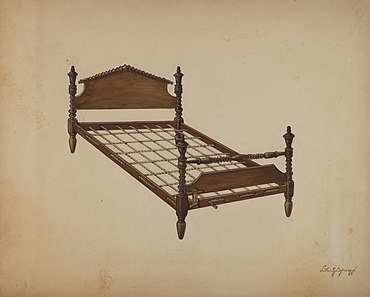


A rope bed is a type of platform bed in which the sleeper (and mattress) is supported by a lattice of rope, rather than wooden slats.
In cold climates, a rope bed would be topped with one or more insulating pailasses or bedticks, which would traditionally be stuffed with straw, chaff, or down feathers. It might also have a canopy hung with warm curtains.[1][2] Modernly, they may be topped by a thin futon (a form of bedtick) or other roll-up mattress[3] (see mattress topper).
In the sixteenth century (England?), bedmats of woven or plaited rush were often laid on the widely-spaced ropes, and the bedticks were laid on the mats. This stopped them from bulging between the ropes.[4]
Rope beds need to be tightened regularly (with a bed wrench, and sometimes with wedges) as they sag. They must also be re-strung occasionally; re-stringing reduces sag and evens out wear.[5][3][6] When fully or partly unstrung, rope beds can be packed flat for transport.[3] The need to tighten bedcords has been said to be the origin of the English phrase "sleep tight", [4] but some etymologists disagree.[7]
![]() Media related to Rope bedframes at Wikimedia Commons
Media related to Rope bedframes at Wikimedia Commons
This article about furnitureorfurnishing is a stub. You can help Wikipedia by expanding it. |